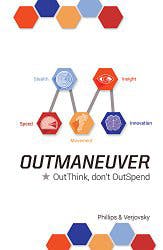Breaking Out of a Commoditized Market: Making Sense of Speed, Agility and Innovation
In an era full of capable executives, new technologies and such rich management thinking and philosophy, why does it seem that every market is destined to become commoditized?
It’s clear that a profitable market will attract competitors and new entrants, who seek to capitalize on the investments first movers made to define and create a market. As more entrants move in, they seek to match product for product, feature to feature, which ultimately leads to commoditization, where the only real differentiators are promotion and price. What we are left with is brutal, bloody competition to win or lose a few points of market share or profits. In the end, every participant in this competition loses, including customers. Market competitors lose because there’s little differentiation or profit left in the marketplace, and customers lose because competitors cannot reinvest in customer service or increase quality in a price driven market.
How does a company break out of a commoditized market, or, better yet, avoid commoditization and expensive head to head competition entirely? In our new book OutManeuver we describe maneuver strategy, a new way of looking at competition, based on stealth, insight, speed, agility and innovation, which stands in stark contrast to the existing competition, which we call “attrition.” Maneuver and attrition have their roots in military strategies, yet only attrition has been fully accepted in the business world. The time is right for maneuver to become a viable competitive strategy, to help companies compete more intelligently and to win the most at the least possible cost.
Attrition versus Maneuver
As we’ve noted, attrition strategy is inherited from military strategy. Attrition seeks to overwhelm and defeat an enemy or a competitor by overpowering or destroying them, regardless of the cost. Attrition is a direct, frontal attack, matching features in a race to the bottom. Attrition is mindless, expensive and leads to commoditization. One military author calls attrition evidence of a lack of strategy.
If attrition is so damaging, why do so many competitors choose attrition as their main competitive strategy? Attrition is simple to plan and execute, requires little forethought or investigation, and is more amenable to slow conflicts where money and time are less important that winning.
Maneuver, on the other hand, is based on winning at the least possible cost. Maneuver leverages speed, stealth, agility, insight and innovation to identify and win valuable, unoccupied markets, segments or channels before competitors are even aware of their existence, and builds barriers to keep competitors out.
When an attack on an existing competitor is required, maneuver strategy provides techniques to analyze a competitor’s or an entire industry’s weaknesses and the means to attack them indirectly, which forces the competitor to abandon their positions or respond with less than their full capability. Maneuver is surprising, unconventional and uses tactics such as time, location, psychology and information to create winning formulas.
Key Differences
Attrition is much simpler to implement, because it simply requires that you match a competitor’s product feature for feature in the same marketplace. Thus, attrition requires little insight or reconnaissance, and can be faster to implement, but is always more expensive to execute than maneuver. Maneuver, on the other hand, always starts with a careful assessment of the industry and the competitor, to find valuable positions that aren’t occupied, or to find a competitor’s weaknesses that are easy to attack. While maneuver may require a bit more thinking up front, it’s impact is disproportionate to the investment, always creating opportunities to win more at much less cost.
This is because maneuver uses specific approaches to evaluate competitive positions and identify key vulnerabilities or weaknesses which are easier to attack. Maneuver emphasizes pre-emption - identifying and taking valuable, unoccupied spaces before competitors become aware of the opportunity.
No competitor demonstrates pre-emption like Airbnb. While the major hotel chains had perfected room reservations for their hotels, Airbnb recognized a surplus of other accommodations existed, and created a reputable reservation system for spare bedrooms, apartments and even houses. Major hotel chains had the capability to manage and reserve these accommodations, but did not expand their horizons to understand and address the opportunities.
Further, maneuver relies on agility and continued movement. Good maneuver strategists recognize that positions and markets aren’t permanent, and don’t get locked into a position in which they can be blocked or attacked. Instead, maneuver strategists are always looking for the next opportunity to move, attack and win new markets or opportunities.
Netflix provides an excellent example of a company constantly attacking and moving. When it first appeared, it attacked Blockbuster by delivering movies through the mail, negating Blockbuster’s physical retail presence. Then, as cable providers and others entered the streaming business, Netflix moved to provide both streaming and DVD rental. Then, taking another leap, Netflix added the ability to create its own content, generating hit shows, moving up the value chain. Netflix realizes the necessity of constant motion, as the industry it competes in is constantly shifting.
Proactive versus Reactive
Perhaps the most important aspect of maneuver is the concept of becoming proactive – constantly seeking out new opportunities and moving to take advantage of emerging markets or segments. Using maneuver, you can extract your company from commoditized competition and move quickly to new markets, or better yet avoid costly head to head competition entirely. Using maneuver, you can move, attack and move again, avoiding the inertia that slows your ability to move and forces you into attrition competition. Attrition is popular with many companies because it aligns to a more passive, reactive mentality, moving and responding only after a new competitor enters the market, using size and market position to win, rather than speed, agility or intelligence.
Enablers
Maneuver is powered by a number of enablers, including speed, agility, insight and innovation. You’ll notice that many of the enablers we identify are already gaining credence in executive circles. We define speed in two ways: planning speed and execution speed. This means that your team must accelerate its ability to make decisions and prioritize resources, as well as its ability to execute on those decisions. Agility is defined as the ability to keep moving as circumstances and plans change, always adapting to new conditions, rather than having to stop and reconfigure. Insight comes from constantly surveying the market, identifying the strengths and weaknesses of existing competitors and new entrants. And no maneuver capability is complete without innovation. Moving quickly creates insights for new products, services, channels and even business models, which may have to be created to take advantage of new opportunities.
Rather than improving key enablers such as speed, agility and innovation independently, we recommend the use of maneuver strategy as a context or framework, to give these enablers a unifying purpose. When speed, agility and innovation work together for a strategic benefit, you can win far more with less investment, break out of commoditized competition or avoid it entirely, generating far more revenue, profits and market share than before.
Attrition strategy is useful, but will almost always lead to expensive competition and commoditization. Maneuver strategy, which requires a bit more planning and insight, can open new opportunities and provide the means to compete with existing competitors that wins the most at the least possible cost. Introducing maneuver strategy as a component of your overall strategy is the right way to avoid commoditization.
Jeffrey Phillips and Alex Verjovsky are the authors of the new book, OutManeuver: OutThink, don’t OutSpend (March 2016). Phillips leads OVO Innovation, an innovation consulting company in Raleigh, N.C. Verjovsky is a consultant, an entrepreneur and a pioneer in the biodiesel market.

